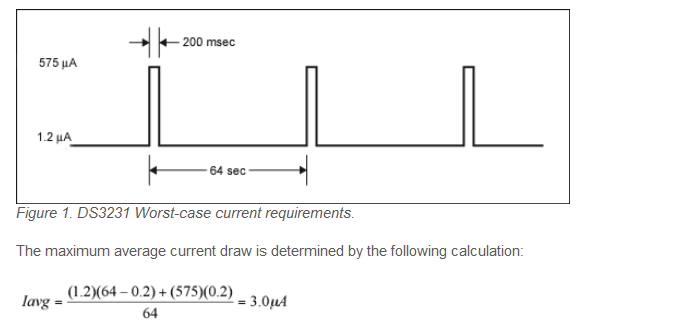Overview
With the introduction of the DS3231 extremely accurate, I²C-compatible, integrated RTC/TCXO/crystal, Dallas Semiconductor has redefined the accuracy expectations of a stand-alone, real-time clock. The DS3231 provides ±3.5ppm of accuracy over the industrial temperature range (-40°C to +85°C). The device achieves this level of accuracy by measuring the device temperature every 64 seconds (64s) and adjusting the load capacitance of the crystal to approach 0ppm accuracy at that specific temperature.
Current Requirements
The periodic temperature update process increases the current requirements of the device for a short period of time (worst case, 200ms). The time chart in Figure 1 demonstrates the worst-case current requirements of the DS3231 over time. All calculations assume a battery voltage of 3.63V with the I²C-compatible interface inactive.

Figure 1. DS3231 Worst-case current requirements.
The maximum average current value of 3.0µA is provided in the DS3231 data sheet. As this value reveals, the temperature conversion process increases the total current requirement by 250%! This current increase is especially significant for applications that require extended operation from a backup power source (e.g. Lithium battery, super capacitor).
Reducing Current Requirements
The DS3232/DS3234 provide a bit field in a user-programmable register that allows the time between temperature updates to be increased, thus reducing the average current requirement. Both devices provide the C_Rate bit field in the Control/Status Register, which provides four different periods between temperature updates. This register is detailed in Table 1.
Table 1. Control/Status Register Bit Assignments
Table 2 shows the time between temperature updates and the resulting worst-case currents for the DS3232/DS3234. All calculations assume a battery voltage of 3.3V with the I²C-compatible interface inactive. This C_Rate bit field will default to zero at power-up, which corresponds to 64s between temperature updates.
Table 2. Time Between Temperature Updates and Resulting Worst-Case Currents
By adjusting this bit field, the current requirements can be reduced by more than 65%, extending the lifetime of a backup power source.
Accuracy
With the increase in time between temperature updates, there could be a reduction in accuracy during rapid temperature fluctuations. There is no affect on accuracy when the temperature remains stable or changes slowly.
Temperature Control
The DS3234 has added a Temperature Control Register that allows an application to disable temperature updates when the device is powered by the back-up power source. The BB_TD bit in this register controls the disable function. This bit defaults to zero at power-up, which corresponds to temperature updates being active. The register is detailed in Table 3.
Table 3. Temperature Control Register Bit Assignments

Enabling this bit reduces the total current requirement of a back up power source, but there will be degradation in timekeeping accuracy without temperature updates.
Summary
With the addition of programmable temperature update times, Dallas Semiconductor has provided accurate timekeeping with lower current requirements by introducing the DS3231/DS3232/DS3234 integrated RTC/TCXO/crystals.
Visit Maximin Integrated for related parts
Advertisement
Learn more about Electronic Products Magazine





